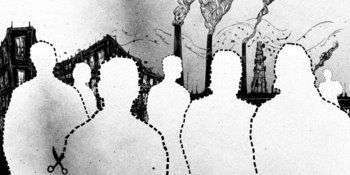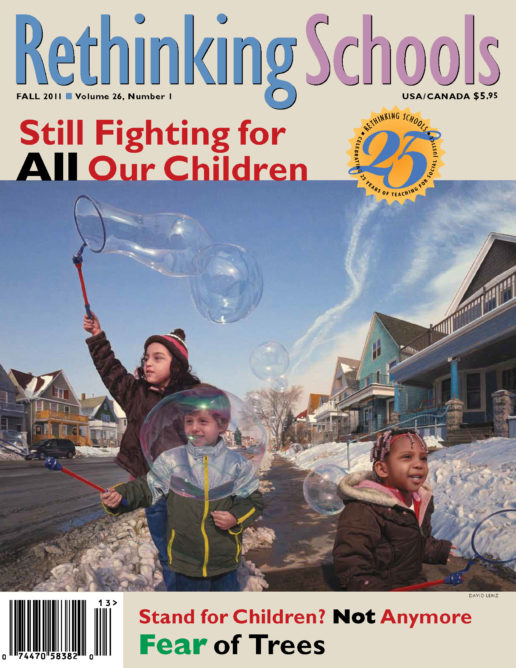What Do You Mean When You Say Urban?
Speaking honestly about race and students
Illustrator: Pete Yahnke Railand

Ethnic, inner city, urban. What do these terms mean in education?
I am a teacher educator who studies how people use language to talk about race. One word that I’ve examined over the past five years is urban. A quick look in the dictionary, and there is no surprise: Urban means related to the city, characteristic of a city or city life. So what does that mean when we say urban education? What is unique about city schools or city education? That depends on the city you’re talking about. In large, densely populated cities, such as Boston, New York, and Los Angeles, city schools are often characterized by large, diverse populations, many poor students, budget shortfalls, and bureaucracy. So why, then, do we use the term urban when what we really mean are schools with majority black and Latina/o populations?
Take for example my city: Portland, Ore. Downtown there is a high school named Lincoln. It is less than a mile from the Pearl District, a hip place that boasts unique food, shops, new condos, and the best of urban renewal. It is a stone’s throw from a soccer stadium and surrounded by tall buildings, people biking to work in suits, folks who routinely beg, and the hub of the public transit system.
Across the river in North Portland, there is a high school named Jefferson. It is surrounded by family dwellings, mom-and-pop shops, and wide streets for biking, walking, and playing. There is a community college across the street.
Which one of these schools is urban? Lincoln? Jefferson? Both?
Before you decide, let me give you a bit more information. At Lincoln, the downtown school, the population is more than 75 percent white, 4.5 percent of the students are black, 8.6 percent are Asian, and 6.6 percent are Latina/o; 10.5 percent are on free/reduced lunch; and the school does not receive Title 1 funding. At Jefferson, the school across the river, 59 percent of the students are black, 8 percent are Asian/Pacific Islanders, and 17 percent are Latina/o; 70 percent are on free/reduced lunch; and the school does receive Title 1 funding.
Made up your mind yet?
A few years ago I interviewed 17 teachers who attended an “urban education” program. I asked them what was the difference, if any, between urban teaching and non-urban teaching. Ruth remarked: “To me, urban students come from an environment where they can’t see the value of education. They can’t see why it matters, because everyone that they know, everything that they do, has nothing to do with having an education.”
Thinking about the definition of urban—related to the city—I can’t help but wonder: What is it about city kids that makes this teacher think they don’t value education? It wasn’t until after three interviews of each teacher that the whole picture emerged, one in which urban was constructed as a code word for race—specifically black and Latina/o—and often for poor. Teachers equated urban with students of color and the characteristics they perceived as belonging to students of color.
At one point I asked these teachers what urban meant and the most often cited response was “racially diverse students.” Now taken as is, this would mean students of a multitude of races—including whites. But it was clear from these interviews that “racially diverse” excluded white students and often left Asian Americans and Native Americans on the side as well.
As Molly noted: “My teacher education program definitely prepared me to be a teacher. I think my school placement prepared me to be an urban teacher. Had I been in the exact same university classes, but had a school placement in Lake Genesis [a majority white high school], I wouldn’t have been prepared to be an urban teacher.”
I wonder, which parts of good teaching translate into all types of schools and which parts don’t? What’s urban about urban teaching?
Two years ago I presented some of my research to preservice teachers. One of them challenged me. “But that is how they act. Urban kids don’t want to learn as much as the other students in class. Their parents don’t care as much, they don’t arrive at school on time, and they don’t get their homework done. So these teachers are just responding to reality. I see it at North High School all the time.”
Reflecting on this, I thought about how he separated his students—all of whom were from the local neighborhood—into two categories: urban and normal. Then I thought, oh yeah, urban means less than. The kids who are doing well, the kids who know how to do school, are normal. And the kids who don’t know how to do school are urban.
Does it matter what language we use? It only matters if you are going to use it to mask your feelings—overly positive or negative—about a certain race or economic group. This is no time for euphemisms and unexamined beliefs about race. Our schools are deeply divided along racial and class lines. We need teachers who will examine themselves as racial beings who teach other racial beings and figure out what they are doing wrong and what they are doing right.
What would it look like to use race words (e.g., African American, European American, Korean American) when thinking about your classroom and curriculum? You might test yourself by starting to use “black” when you really mean it instead of low achieving, underserved, at-risk, our kids, those kids, inner city—or urban.
So what do you mean when you say urban?

